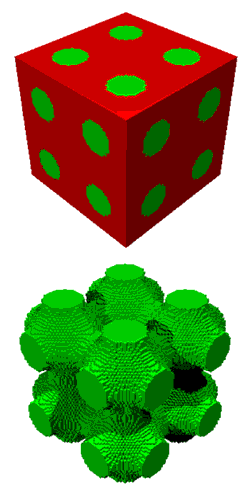Minimalist’s Tug-of-War

Spider silk must be light, elastic, and strong–all at once. Drawing inspiration from natural materials that must balance such competing demands, researchers have used computer simulations to calculate the microstructure of a material that simultaneously conducts both heat and electricity. The surprising shape that resulted provides the first simple example of the effects of competing demands on mixtures of two materials, and may offer materials engineers a way to solve a range of similar problems. The results appear in the 23 December print issue of PRL.
Biological materials are often composites of two or more substances that can simultaneously perform several tasks well–such as provide mechanical support, conduct electricity, or transport fluids and particles. To Salvatore Torquato of Princeton University, that fact suggests at least a rough sort of optimization at work. A mixture optimized for a single property, such as heat conduction, looks like blobs of one material suspended in another. But no clear, simple examples exist for the structure resulting from a two-property tug-of-war in a mix of two materials.
Now Torquato and his coworkers have adapted a method called topology optimization to simulate a mix of two phases, one that conducts heat well and one that conducts electricity well. These specific properties were chosen for their simplicity. After the researchers make a first guess at the arrangement, the program morphs the guess this way and that until it finds a shape that maximizes both heat and electrical transport.
The resulting boundary between the two phases turned out to be a so-called bicontinuous, triply-periodic, minimal surface. “Bicontinuous” means that each phase extends from one side of a sample to every other side without interruption, rather than one phase being immersed in the other. It has a repeating pattern in all three directions (“triply-periodic”). And the material boundary has the minimal surface area possible for a surface with the first two properties. To understand a minimal surface, think of a soap film on a wire frame bent into a complicated shape. The soap film is minimal because of surface tension, but the simulated minimal surface comes from the competition between the two properties and “is completely unexpected,” says Torquato. He’s unaware of any other physical mechanism for minimizing a surface besides surface tension.
The technique should extend to any combination of two or more physical properties, including chemical, mechanical, and optical characteristics, he says. One practical example might be mass and electrical flow in batteries. To Torquato, the result also implies that there might be signs of optimization, however incomplete, in biological systems. Certain cell membranes resemble periodic minimal surfaces, for instance.
The biological angle may not pan out, but the authors’ work represents a fascinating conjecture, says mathematician Robert Kohn of New York University. The topology optimization method employed is a powerful technique that remains relatively unknown, he says. It isn’t clear why the competing demands of material properties can mimic the effect of surface tension and lead to a minimal surface, but Kohn hopes those in the field can establish the connection. “It would be nice of course to have a proof. But that’s work for the rest of us.”
–JR Minkel
JR Minkel is a freelance science writer in New York City.


